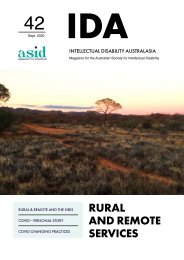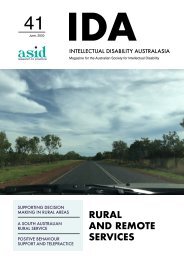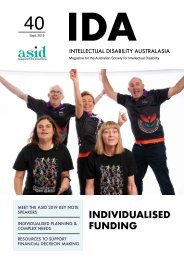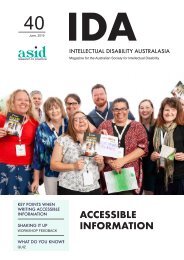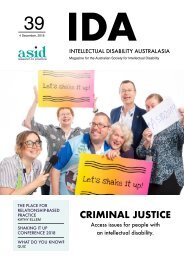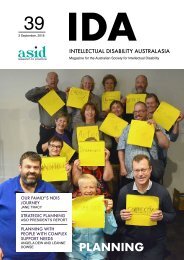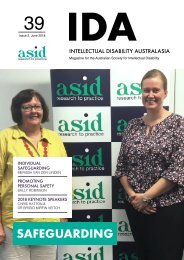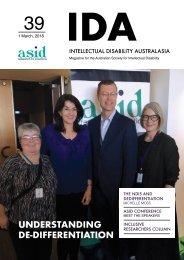IDA Vol 40 Issue 4 - ASID (Dec 2019)
You also want an ePaper? Increase the reach of your titles
YUMPU automatically turns print PDFs into web optimized ePapers that Google loves.
to change attitudes in society to allow their full participation:<br />
People just don’t want to give us a go, um, and that could be anything you know. It could be how we<br />
look, to how we talk, to how we go about doing things, I think. (Paul)<br />
I think they think that people with disabilities can’t do things, so they’re not gonna give them that time<br />
to try (Michael).<br />
Paul and Michael were regular participants in the first years of the Ability Radio Project and talk about<br />
the value of participating in the group and more broadly in the media, where they both agreed they did<br />
not often hear people like them:<br />
I think it would be easier if there were other people with disabilities who want to be on the radio as<br />
well. So we are not the only ones who’ve got a disability on the radio. There should be more people<br />
with disabilities on the radio, so they’ve got a voice on the radio as well. Than just us (Michael).<br />
Michael points to the need to change attitudes by increasing the presence of people with disability on-air,<br />
particularly valuing his capacity to help lift up others along with himself.<br />
Other participants in the research also expressed their enthusiasm for participation in community radio to<br />
enable others to have a voice. Scott Whelan, a school teacher who has cerebral palsy, has become the<br />
station manager at this suburban Adelaide station since the publication of the research he participated in.<br />
He says,<br />
Without getting all hippy and stuff, it’s a sense of satisfaction that I’m contributing to something<br />
worthwhile. …Community radio is like the people’s radio… and people with disabilities are part of<br />
people, there should be more of them. If they are out there and they want to have a go (Scott).<br />
Scott’s message resonates with the values of the community media sector that has long seen itself as ‘a<br />
voice for the voiceless’.<br />
Effective listening has a social change aspect that can redirect the effort of activism towards the<br />
“conventions, institutions and privileges which shape who and what can be heard in media” (Dreher,<br />
2010, p. 85). While disability activism is a powerful way to raise awareness, Dreher and Mondal (2018)<br />
suggest that inequity can only be addressed when the powerful also work to address their privilege and<br />
meaningfully dialogue with the powerless “on their own terms rather than on the terms dictated to them<br />
by established elites” (p. 10). As in other parts of the community, formal and informal hierarchical power<br />
imbalances exist in community media. However, it is social justice principles make this sector ripe for<br />
social change towards more inclusivity.<br />
There is some evidence that the community broadcasting sector is listening and changing. In <strong>2019</strong><br />
the RPH Radio Reading Network, which provides print reading on-air for people with a print disability<br />
(including those with intellectual disability) commissioned the development of resources to help<br />
community radio stations improve their accessibility. The peak training body, the Community Media<br />
Training Organisation has developed training for community radio stations to make the best use of those<br />
resources and since 2016 disability has been a part of the yearly Community Broadcasting Association<br />
of Australia’s conference.<br />
Disclaimer: This article was written by Kim Stewart in consultation with Paul O’Dea and Michael Cherry.<br />
<strong>Vol</strong> <strong>40</strong>, <strong>Issue</strong> 4, <strong>Dec</strong>ember <strong>2019</strong><br />
9





